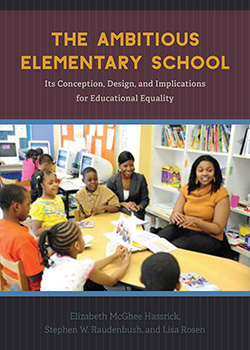“The Ambitious Elementary School:” Q&A on Educational Inequity
April 3, 2019
Elizabeth McGee Hassrick, PhD, an assistant professor in Drexel’s A.J. Drexel Autism Institute and Department of Sociology, and colleagues spent five years investigating a charter elementary school in Chicago with a remarkably different educational model. The results? Students in the charter school — most of whom were admitted through a random lottery — had significantly higher test scores than peers in other schools, an effect that continued at least through middle school. The students’ results also nearly closed the racial achievement gap in the city.
Hassrick explains what makes this school model different with insights from the research she conducted with Stephen Raudenbush and Lisa Rosen. Their results are published in their co-authored book, “The Ambitious Elementary School: Its Conception, Design, and Implications for Educational Equality,” University of Chicago Press.
As the book notes, the problem of educational inequality is enormous — even overwhelming. What drew you to this topic, and to Chicago specifically?

My first career was as a classroom teacher in high-poverty public school districts, where my passion was making my classroom a welcome home for my students’ parents. For my master’s degree, I studied how to collaborate with the parents of my primary-grade Navajo and Hispanic students, to find ways to teach reading through sharing cultural stories and family narratives.
For my PhD, at the University of Chicago, I sought to learn how to use social network evidence to help forge trusting relationships between low-resource, racially and ethnically diverse families and school staff. I picked sociology for study because of the discipline’s commitment to inequality in the family, the community and the school. I wanted my efforts to be empirically informed from multiple vantage points.
For graduate school, I applied to the sociology department at the University of Chicago to work with Tony Bryk, EdD, the professor who started a charter school dedicated to providing low-resource, urban students and their parents with the resources and supports they needed to address educational inequality across race, ethnicity and social class. His commitment to fostering ambitious evidence-based teaching and learning for students in low resource families greatly inspired me.
What is the “ambitious elementary school”? How does it differ from traditional elementary schools?
The ambitious elementary school model that we investigated for the book was built upon three main imperatives:
- Ambitious intellectual work for every child
- Organizing teachers’ work to ensure that every child is immersed in ambitious intellectual work
- Mobilizing broader support for student learning
The UChicago Charter School’s founders believed in ambitious learning goals that were shared among school leaders, staff and parents, with subject matter that was engaging, intellectually challenging, and relevant to students’ lives. Like many conventional approaches to teaching, the UChicago school emphasized phonics, facts and procedures. However, they also placed priority on the co-development of “higher-order” abilities, such as the capacity to synthesize and explain complex ideas, interpret and construct arguments, test hypotheses, discover patterns, evaluate claims, and support conclusions with evidence.
Teachers were embedded in support teams at the school, with easy access to instructional leaders; school leaders were connected to families and community resources; and school social workers were committed to the wellbeing of all students, not just students with designated special needs. These broader supports allowed teachers the resources they needed in their everyday work to ensure that their students were immersed in the kind of ambitious intellectual work that promoted growth in their learning. In contrast, teachers in traditional schools are often isolated in their classrooms without shared, systematic supports, expected to accelerate student learning on their own.
Your research took you to Chicago charter schools for five years. Do any moments or interactions from that time stand out?
For me, my favorite part was always being in schools watching the “shop floor” of learning take place. Especially revealing were the drop-off and pick-up times at the UChicago charter school, where I witnessed school leaders, social workers and classroom teachers informally networking with anxious parents and grandparents — to learn what caregivers wanted for their children and share knowledge about how to best support their children’s learning.
What did your team uncover about addressing educational inequities?
Our team was able to demonstrate, using rigorous statistical methods, that the ambitious model of schooling at UChicago positively impacted student learning. Our book not only provides evidence of the effectiveness of the elementary ambitious school model, but also details the everyday organizational routines and processes that enable low-resource, urban students to thrive.
What’s next for your research agenda?
I currently use social network methods to research the shared, systematic provision of support for children on the autism spectrum, helping multidisciplinary teams connect with family and community providers to create better outcomes for children and young adults on the autism spectrum.